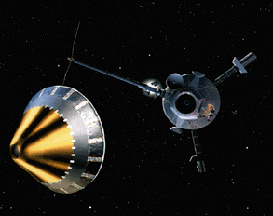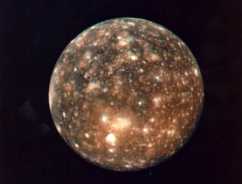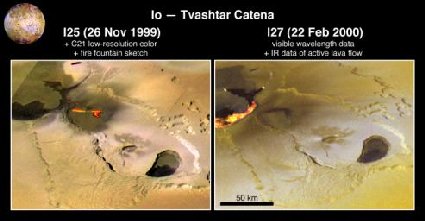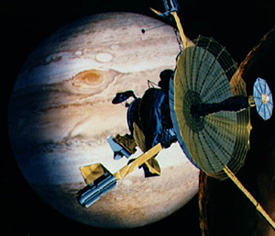An artist's drawing of the Galileo spacecraft in orbit around Jupiter
Click on image for full size
Image courtesy of NASA
Galileo - The Sequel
News story originally written on January 2, 1998
Galileo concluded its remarkable primary mission on December 7, 1997. It spent the last two years studying
Jupiter and its moons.
Galileo has already begun part II of its mission. This phase of the mission will last another two years and will include eight Europa flybys, four Callisto flybys and one or two Io encounters, depending on the spacecraft's health.
The Galileo spacecraft completed its first flyby of Europa on December 8th. It reached within 124 miles (200 kilometers) of the surface of the moon. Europa has become increasingly important as scientists have recently realized that underneath its icy surface, Europa may have liquid oceans (that's not to say that they are liquid water!).
"Galileo has earned a place in history as the first mission to orbit an outer planet," said Dr. Wesley T. Huntress, Jr., NASA's associate administrator for space science, Washington, DC. "Galileo already has returned a wealth of new information in its two-year scientific exploration of Jupiter's atmosphere and system of moons. But the best yet may still be ahead of us as Galileo continues its mission at Jupiter with a focus on the moons Europa and Io in the next two years."
You might also be interested in:

The Galileo spacecraft was launched on October 19, 1989. Galileo had two parts: an orbiter and a descent probe that parachuted into Jupiter's atmosphere. Galileo's primary mission was to explore the Jovian
...more
Europa was first discovered by Galileo Galilei in 1610, making it one of the Galilean Satellites. Europa is Jupiter's 4th largest moon, 670,900 km from Jupiter. With a diameter that is about half the distance
...more
Callisto was first discovered by Galileo in 1610, making it one of the Galilean Satellites. Of the 60 moons it is the 8th closest to Jupiter, with a standoff distance of 1,070,000 km. It is the 2nd largest
...more
The Galileo spacecraft was launched in October 1989, aboard the shuttle Atlantis. Galileo has been orbiting Jupiter for more than five years and it is still going strong! "We're proud that this workhorse
...more
It was another exciting and frustrating year for the space science program. It seemed that every step forward led to one backwards. Either way, NASA led the way to a great century of discovery. Unfortunately,
...more
The Space Shuttle Discovery lifted off from Kennedy Space Center at 2:19 p.m. EST, October 29th. The sky was clear and the weather was great as Discovery took 8 1/2 minutes to reach orbit for the Unitied
...more
A moon was discovered orbiting the asteroid, Eugenia. This is only the second time in history that a satellite has been seen circling an asteroid. A special mirror allowed scientists to find the moon
...more















